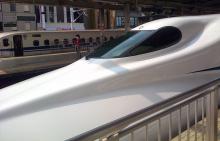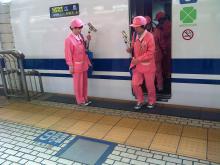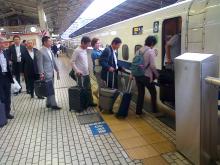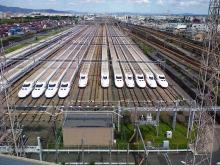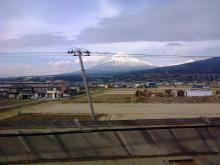The article first appeared in Vol. 1, No. 2 of The Rail Enthusiast
I am at Tokyo station, on the platform, waiting for the Nozomi Shinkansen to Osaka. Passengers have queued in at the entrance to their respective coaches in an orderly line, in a fuss free manner. It is the middle of April this year and I am on a trip to Japan.
Standing at one end of the platform is the driver who will take over the train from Tokyo. She is a petite, 5-foot tall young lady, who stands in stark contrast to the massive piece of machinery that she is about to pilot. Quiet, focused and smiling, she is not the only crew member on the platform. Also present, and precisely positioned at the entrance to every coach, is the cleaning crew. Most of them appear to be in their 50s and are dressed in a light pink dress.
As the train gets in, the passengers remain in their respective queues, not moving, not disrupting the orderliness that has been in existence prior to the train’s arrival. Most of the passengers are on their phones, some of them are with books or magazines.
The train stops at the platform. The passengers disembark, needless to say, in an orderly fashion. As they disembark, the cleaning crew positioned close to the door of the coach, bows.
The cleaning supervisor then gives the signal, and the cleaning crew gets in.
All of us passengers, who have to get on to the train, are still on the platform. The cleaning crew is in.
I watch from the platform, through the windows.
With the cleaning crew inside, there is a flurry of activity that can be seen. In a minute or so, it is easy to figure out a pattern. They check for trash in front of every seat and put it in their plastic bags. They check the luggage racks for any remnants from the journey the train has just completed. They wipe the floor inside the coach. They turn the seats to face the direction of travel – the seats have a revolving mechanism. The window shades are all lifted. In about seven minutes, the train has a completely new look.
The cleaning crew comes down. The train is now ready to have its new set of passengers on board. The passengers get in. The crew bows again.
Passengers settle in. I am in the Green car, which is about 70% full.
The scheduled time of departure was 10.23. I wondered when exactly the train would leave. Don’t get me wrong; 10.23 was never a question. My question to myself was whether it would leave as soon as the clock stuck 10.23, i.e. the next second after 10:22:59; or would it leave at 10:23:59 seconds, or somewhere in between? We departed at 10:23:15.
In this day and age, setting one’s watch is no longer necessary because phones synchronize time from mobile networks. However, setting it to the Shinkansen timing is a very credible and highly accurate alternative.
I had read earlier about the Japanese Railways publishing statistics on Shinkansen punctuality timings every year. I recalled from that article that the average delay in the entire year of 2012, aggregated over all trains on all routes, was 36 seconds. This was considered to be a poor performance, when compared to the 1997 record of 18 seconds.
We depart Tokyo, and in a few minutes, we reach Shinagawa station. Shinagawa is one of Japan’s oldest railway stations, and is one of Tokyo’s busiest, after Tokyo station. A few passengers board.
A ticket checker enters the coach. She bows on entry. As she goes about her job with the minimum of fuss, she covers all passengers in a few minutes.
Next up is Shin-yokohama station. A few more passengers board; the train is almost full. The seat next to me is still empty.
The train’s really picked up speed now. I had an app on my phone that can determine the speed – at one point, it shows 302 km/h.
A while later, there is a refreshment cart that is passing through. I ask for Japanese green tea. I also ask her about Mount Fujiyama and what time could I see it. She checks her watch. She says, in 13 minutes.
Mount Fuji, called Fuji-san, with the honorific ‘san’ suffixed like most other things in Japan, is highly revered by all Japanese. Fuji-san is as much about cultural heritage as it is about natural heritage. It is the highest mountain in Japan, with a perfectly symmetrical conical shape. The fact that it is an active volcano does not worry too many people, as its last volcanic activity was in 1707. There has been speculation about an imminent volcanic eruption post the 2011 earthquake and Tsunami, with several mathematical models suggesting danger. That does not deter too many Japanese from continuing to revere and visit Fuji-san.
The weather is clear, and from my train window, I get a clear, uninhibited, picturesque view of Japan’s most famous geographical structure. My phone camera gets very busy.
The journey continues. The train stops at Nagoya next, which is a little more than midway between Tokyo and Osaka.
Curious to know more about the Shinkansen, I open the internet through the wifi network on the train. I figure out that the literal meaning of the word Shinkansen is ‘New trunk line’, but the word is used interchangeably with ‘bullet train’ and sometimes, with the phrase ‘super express’.
Kyoto follows. A few passengers disembark from my coach.
A while later, there are announcements about Shin-Osaka approaching. The 515 km journey takes about two-and-a-half hours.
As I disembark, I reflect upon the multiple trips to Japan that I have done in the last three years. There are several things about Japan and the Japanese people that I find absolutely fascinating –politeness, respect, order, patience, dignity, diligence, helpfulness, simplicity. Many great ideas are implemented pragmatically, with absolute precision, and they form the building blocks of several systems in Japan.
The Shinkansen is, in a way, an embodiment of all of that. And more. A testament a to uniquely Japanese way of integrating technology with a unique human experience.

